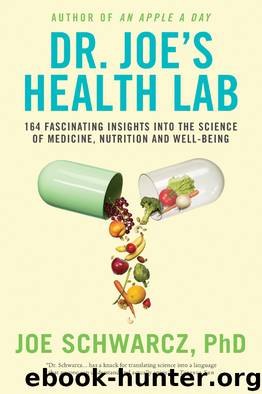Dr. Joe's Health Lab by Joe Schwarcz

Author:Joe Schwarcz [Schwarcz, Joe]
Language: eng
Format: epub
ISBN: 978-0-385-67157-6
Publisher: Doubleday Canada
Published: 2011-10-31T16:00:00+00:00
What food product is made through “interesterification”?
Interesterification is a process to produce trans fat–free margarine. Margarine originally was a cheap butter substitute made by emulsifying beef fat with water or milk. Eventually, animal fat was replaced by vegetable fats hardened by the process of hydrogenation, mainly for economic reasons. When saturated fats were linked with increased levels of cholesterol, margarine became a quasi-drug, at least until trans fats—by-products of the hydrogenation process—reared their ugly heads.
Interesterification replaced hydrogenation with a view towards eliminating trans fats. In order to throw some light on how this happens, we have to dig into the chemistry of fats. Fats are triglycerides, meaning that there are three fatty acids attached to a molecule of glycerol. An analogy would be a comb with three teeth, with the teeth being the fatty acids. The fatty acids are characterized by two features: the number of carbon atoms in the molecule and the number of double bonds between carbon atoms. Short-chain fatty acids have fewer than six carbons, medium-chain fatty acids have six to twelve, and long-chain fatty acids have more than twelve carbons. Saturated fats have no double bonds, monounsaturated have one, and polyunsaturated fats have two or more double bonds.
The physical properties of triglycerides are determined both by the carbon chain length and the degree of unsaturation. Shorter chains and more double bonds mean the fat is more likely to be a liquid. Olive oil, for example, is composed of 75 per cent oleic acid (18 carbons and one double bond), 16 per cent stearic acid (18 carbons, no double bonds) and 9 per cent linoleic acid (18 carbons and two double bonds). Beef fat, on the other hand, is about 50 per cent saturated fat, mostly palmitic acid (16 carbons) and stearic acid (18 carbons). Butter fat is similar. Saturated fats, particularly palmitic, tend to drive up cholesterol, whereas unsaturated ones don’t.
The idea behind margarine is to produce a product that has less saturated fat than butter but is not too liquidy to spread on bread. There are several ways to do this. The traditional way has been to eliminate double bonds in a vegetable oil by the addition of hydrogen. Of course, elimination of all the double bonds would result in a hard fat similar to butter, so only some of the double bonds need to be eliminated. Partial hydrogenation can do this, but it also introduces a problem: the hydrogenation process produces some trans fatty acids as a side product, and these of course have been implicated in heart disease.
How, then, can a liquid fat be turned into a soft solid without hydrogenation? The answer lies in a process known as interesterification. Basically, this is the replacement of one or two of the unsaturated fatty acids in a triglyceride with a saturated fatty acid. Here is how the process works: A liquid fat that has mostly unsaturated fatty acids connected to its glycerol backbone is mixed with a solid fat such as glyceryl tristearate. The solid fat can be made by total hydrogenation of a vegetable oil such as soybean oil.
Download
This site does not store any files on its server. We only index and link to content provided by other sites. Please contact the content providers to delete copyright contents if any and email us, we'll remove relevant links or contents immediately.
Nutrition for Sport, Exercise, and Health by Spano Marie & Kruskall Laura & Thomas D. Travis(3560)
Nutrition for Sport, Exercise, and Health by Marie Spano & Laura Kruskall & D. Travis Thomas(3554)
The Sprouting Book by Ann Wigmore(3419)
Flavor Flours by Alice Medrich(2650)
Memory Rescue by Daniel G. Amen(2262)
Superfood Smoothie Bowls: Delicious, Satisfying, Protein-Packed Blends that Boost Energy and Burn Fat by Chace Daniella(2240)
Dirty Genes by Ben Lynch(2164)
The Bad Food Bible by Aaron Carroll(2126)
The Poisoner's Handbook by Deborah Blum(1984)
Genius Foods by Max Lugavere(1978)
Good Calories, Bad Calories by Gary Taubes(1957)
The Main Street Vegan Academy Cookbook by Victoria Moran(1943)
The I Quit Sugar Cookbook by Sarah Wilson(1881)
Core Performance Essentials by Mark Verstegen(1864)
Memory Rescue: Supercharge Your Brain, Reverse Memory Loss, and Remember What Matters Most by Amen Dr. Daniel G(1851)
Big Girls Do It Stronger by Jasinda Wilder(1806)
Android App Development by Franceschi Hervé J.;(1736)
Sugar Crush by Dr. Richard Jacoby(1690)
Dr. Colbert's Keto Zone Diet by Don Colbert(1550)
